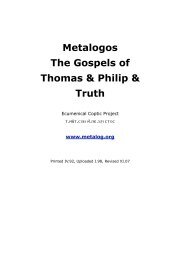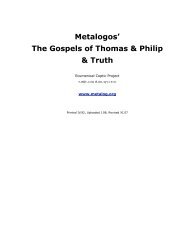Andrew Louth - Syriac Christian Church
Andrew Louth - Syriac Christian Church
Andrew Louth - Syriac Christian Church
Create successful ePaper yourself
Turn your PDF publications into a flip-book with our unique Google optimized e-Paper software.
LIFE AND TIMES 5<br />
about the religious attachment of the court, and second, his love for a<br />
life of quiet prayer. The latter reason is perfectly plausible, 7 but the<br />
former is problematic. By 618 Maximus had already made sufficient<br />
progress in the monastic life to have acquired a disciple, the monk<br />
Anastasius, who was to be his companion for the rest of his life. 8 Six<br />
or seven years later (624/5), Maximus had left his monastery at<br />
Chrysopolis for the monastery of St George at Cyzicus (now Erdek, on<br />
the south coast of the Sea of Marmara).<br />
It is from this period at Cyzicus that Maximus’ earliest writings<br />
have been usually dated: several letters, including four to John the<br />
Cubicularius (one of the Palace eunuchs) in Constantinople, and<br />
several of his treatises on the spiritual life, notably The Ascetic Life<br />
and the four Centuries on Love (the second letter, to John the<br />
Cubicularius, translated below, is itself a remarkable brief treatise on<br />
love). It is also from his time at Cyzicus that Maximus came to know<br />
the Bishop of Cyzicus, John, to whom the earlier Books of Difficulties<br />
is addressed: doubtless it grew out of discussions that took place<br />
between the learned monk and his bishop. It seems, however, that the<br />
Difficulties were not themselves composed at Cyzicus, but after<br />
Maximus had arrived in North Africa. For after only a few months at<br />
Cyzicus, in 626, Maximus and the monks of St George fled south. The<br />
year 626 saw the great siege of Constantinople. The Persian army,<br />
having conquered Syria and Palestine, crossed Asia Minor and<br />
together with the Avars and the Slavs, who were approaching<br />
Constantinople through Thrace, made an ultimately unsuccessful<br />
attempt to take the Queen City: the Asiatic coast of the Sea of<br />
Marmara and the Bosphorus were the subject of raiding by the<br />
advancing Persians, and many fled, including Maximus and his<br />
companions. Maximus ended up in Carthage in North Africa: on the<br />
way it seems that he spent some time in both Cyprus and Crete. It is<br />
usually argued that Maximus arrived in North Africa by 630. The<br />
reason for this is his close association with Sophronius, a learned<br />
monk who had been born in Damascus and in 634 was elected<br />
Patriarch of Jerusalem. He had already left North Africa in 633,<br />
when he went to Alexandria, and yet Maximus regarded him as his<br />
spiritual father and abbot and must have been at his monastery called<br />
Eucratas in North Africa long enough for such a relationship to have<br />
developed.<br />
So far the account of Maximus’ life has been drawn from the Greek<br />
Life and the evidence of his own writings. But about twenty years ago,<br />
a <strong>Syriac</strong> Life of Maximus was discovered in the British Museum by Dr<br />
Sebastian Brock, which tells rather a different story. 9 According to<br />
this account, Maximus was born in the village of Hesfin, east of Lake<br />
Tiberias (the ‘Sea of Galilee’ of the New Testament) in Palestine, 10 the




